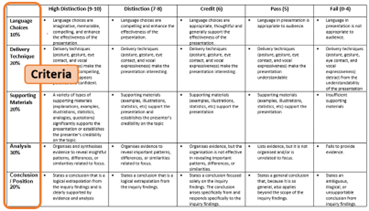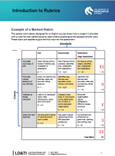A rubric is a marking guideline or grading schedule that provides students and teachers with details on how work is to be assessed. Rubrics are typically set out on a grid or table format and outline a number of relevant assessment criteria with corresponding quality standards. Standards are usually expressed on a point scale indicating lowest to highest level of performance that students can achieve. It is official university policy to provide students with clearly written assessment criteria, regardless of the type of assessment activity.
Ideally, a rubric includes a description of what should be addressed in an assignment, information for the teachers who will be assessing the assignments, and the criteria and standards for student work.
A good set of criteria and standards:
- defines the quality of work you expect from students;
- guides students (and teachers) in their work;
- provides a clear framework to grade work;
- provides feedback to students; and
- helps with evaluating assessment tasks by providing a definable framework.
Rubric Criteria
The criteria define the properties or characteristics of student performance in an assessment task. The standards detail the standards of performance, usually with several levels of performance specified, ranging from fail to high distinction for each criterion. The descriptors provide a detailed description of the standard required for each criterion, allowing students to understand precisely what evidence is needed to achieve each level of performance.
Criteria:
- can be task based or skills based
- should not overlap
- should be aligned to learning outcomes and assessment instructions
- should be weighted
When writing your rubric:
- Include a manageable number of criteria. A maximum of six is recommended (dependant on marking budget, context of assessment, complexity of assessment and assessment weight in course, etc.)
- Identify observable aspects of performance that you wish students to demonstrate (e.g. behaviours, characteristics, skills)
- Criteria are often written as brief themes (e.g. “Quality of reference material”, “Statistical analysis”), or as Verb + Context:
| VERB Level of cognition | CONTEXT What students should be doing | CONTEXT What lens should be applied |
|---|---|---|
| Explain |
how contemporary leaders can foster innovation |
to improve organisational performance.. |
| Apply |
user experience techniques and interface design practices | to web development. |
| Advise |
a client about the options available to them |
within the civil justice and dispute resolution landscape. |
Rubric Descriptors
Rubric Descriptors describe the achievement of each criterion at different standards of achievement.
When writing rubric descriptors:
- Begin with the Pass level first, stating the minimum requirements to meet the learning outcome/s. Then, complete High Distinction, Distinction, Credit, and Fail.
- Focus on what to do, rather than what not to do.
- Use clear language understood by both students and markers.
- Minimise use of adjectives (e.g. excellent, adequate, limited, etc.). Provide descriptive statements
Rubrics can benefit both teaching staff and students by:
- reducing student enquiries by providing expectations on the quality of student work
- reducing student complaints about marking by clarifying the marking criteria used
- providing an efficient method of giving feedback on assessment
- improving consistency of grading, particularly when multiple people are marking assessments.
What does good rubric look like?
A good quality rubric has criteria and standards that are:
Well aligned | Ensure criteria and standards align closely with the task and the course outcomes. This way they will provide a valid measurement of students’ achievement. |
|---|---|
Distinct | Each standard should be distinct and definite. If not, there will be ambiguity in the levels of quality, and marking will not be reliable. |
Clear and succinct | Words that are ambiguous in their meaning should be avoided at all costs. This will also impact upon reliability. |
Reasonable | Work of each standards must be at a reasonable level for the marks indicated. In particular, the top standard should be achievable, but only by work of the highest quality. |
At an appropriate level | Standards should not be too trivial or easy to achieve, nor should they be impossible to achieve. |
Click on the image to see a simplified example of a rubric that has been used to mark an assessment item.
The University of Newcastle acknowledges the traditional custodians of the lands within our footprint areas: Awabakal, Darkinjung, Biripai, Worimi, Wonnarua, and Eora Nations. We also pay respect to the wisdom of our Elders past and present.


